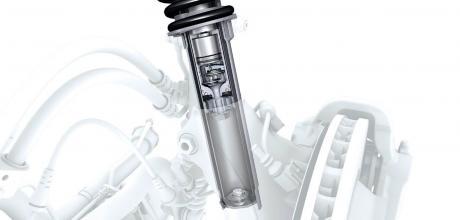What the PASM?

With an engineering background and previous career in Formula One, performance driver coach Neil Furber reveals his blend of driving tips and vehicle technology explanations to help you get more from your rear-engined machine.
Somewhat of a Stuttgart stalwart since the 997, PASM has long been a hot topic among customers who are new to the world of Porsche. Referring to its full name hints at what secrets lie within the acronym: Porsche Active Suspension Management. Whether you choose it for the proper sports cars like the 911 or it comes as part of the range-topping air suspension on the performance SUV end of the spectrum, PASM provides electronic trickery within the damping system.
Dampers provide a necessary counterpart to the coil (or air) springs used in all modern Porsches (and the torsion bar predecessors in older models). While the springs support the weight of the body and all other ‘sprung’ components (pretty much everything bar the suspension, brakes and wheels), dampers are needed to provide dynamic control, and tune the onset of dynamic behaviour including body roll and limiting disturbance as you ride the bumps. A little technical perhaps, but bear with me because it helps to relate to the driving experience you’ll witness at the wheel of a PASM-equipped car.
At this point, we must state that so-called standard suspension is far from basic and offers superb handling. Porsche has developed a well-deserved reputation for its tuning of the balance between both ride and handling. What PASM adds to the mix is a wider range of options to provide more of the good stuff at both ends of the spectrum. In the default mode your 911 will ride bumps just that little bit more gently than a standard car. Press the button to activate the Sport mode(s) and things firm up in the damping department. You’ll experience sharper cornering response – a car that feels more instant in response to your steering inputs – as well as less compliance when the road undulates.
Crucially, the system is active. A raft of sensors and computer calculations keep an eye on what’s going on and can tune behaviour within the operable range. In Normal mode, the car is no slouch despite ride comfort being much more than acceptable for a car with sports suspension. It’s in undulating sections where things work particularly well: the wheels follow the road surface with minimal body disturbance. Traction is maintained even during strong acceleration and the car feels beautifully planted. Under certain conditions, the extra suppleness improves upon standard suspension.
Unlike PDCC (Porsche Dynamic Chassis Control), which physically limits roll angle, pressing the PASM button doesn’t truly make the car corner flatter. Because dampers are speed-sensitive, force-generating devices, the way you drive the car dictates what you’ll feel. Throw the car into a bend in Sport mode and it’ll feel more agile; its keener to change direction with less sensation of roll at entry. Essentially, the loaded suspension isn’t compressing as quickly – it makes the springs feel artificially stiffer than before. This Sport mode slows the roll (and pitch) rate rather than limiting ultimate angle. For short corners and quick inputs, roll feels limited and the car is temporarily flatter. If you’re in a long corner (or follow a complete circle) then your Porsche will reach the same degree of lateral tipping no matter the mode.
Smooth out your steering and PASM’s Jekyll-and- Hyde-esque persona is less noticeable. While lapping the handling circuit at the Silverstone-based experience centre, I’ve rarely felt the need to bother pressing the little button. By contrast, there’s an undulating road cutting through the woods not too far from the circuit, and there PASM in the softer mode is an absolute delight. Pressing the button baits the rear tyres under full power acceleration with a whiff of wheel spin as the rear goes light. Luckily, the system is active and so will migrate within the range as it senses how the car is riding, with the default mode offering greater breadth. Drive it harder and things stiffen up; ride the bumps and it softens off. Use of the button just sets your principal range, with the default able to firm up more than Sport will soften off. When it comes to buying a used 911, is PASM essential? In short, no. Porsche’s standard suspension is already well tuned. PASM adds some additional computer-controlled finesse at the expense of possible electronic gremlins and elevated replacement part prices. Ideally, you should test cars with and without the system as well as how PASM reacts in more undulating conditions, if you’re concerned about whether or not to seek this technology in the used car market.
The slower your inputs for the steering and brakes, the less noticeable PASM’s behaviour under braking and corner entry. With my driving style, I’ve found less difference than some people until the going gets rougher, but ultimately the choice is yours. You can find more information on Neil and his driver coaching by visiting drive7tenths.com.

